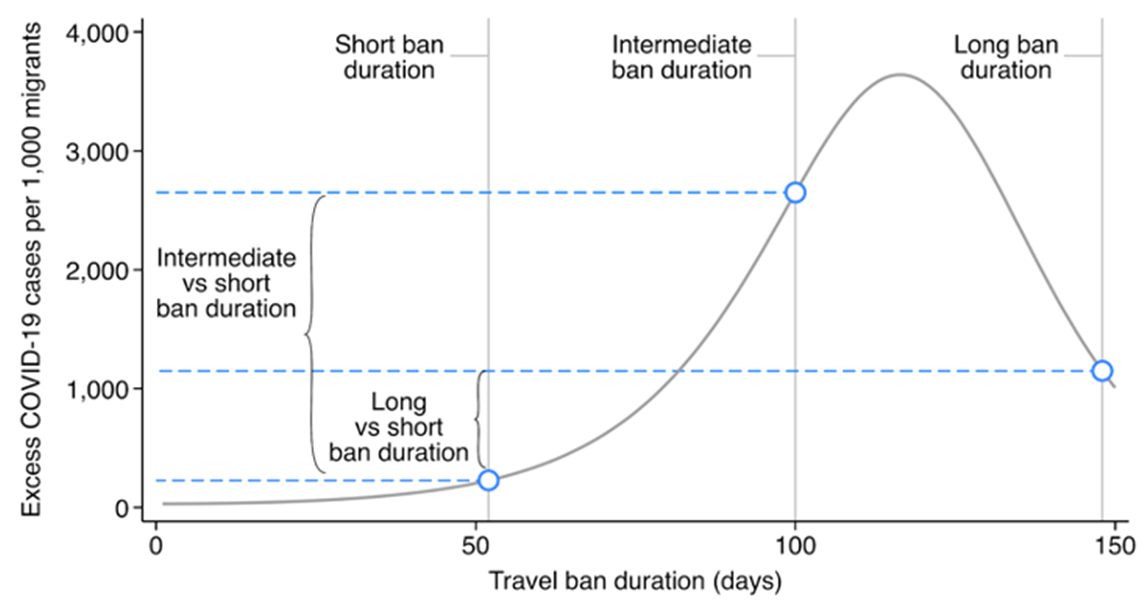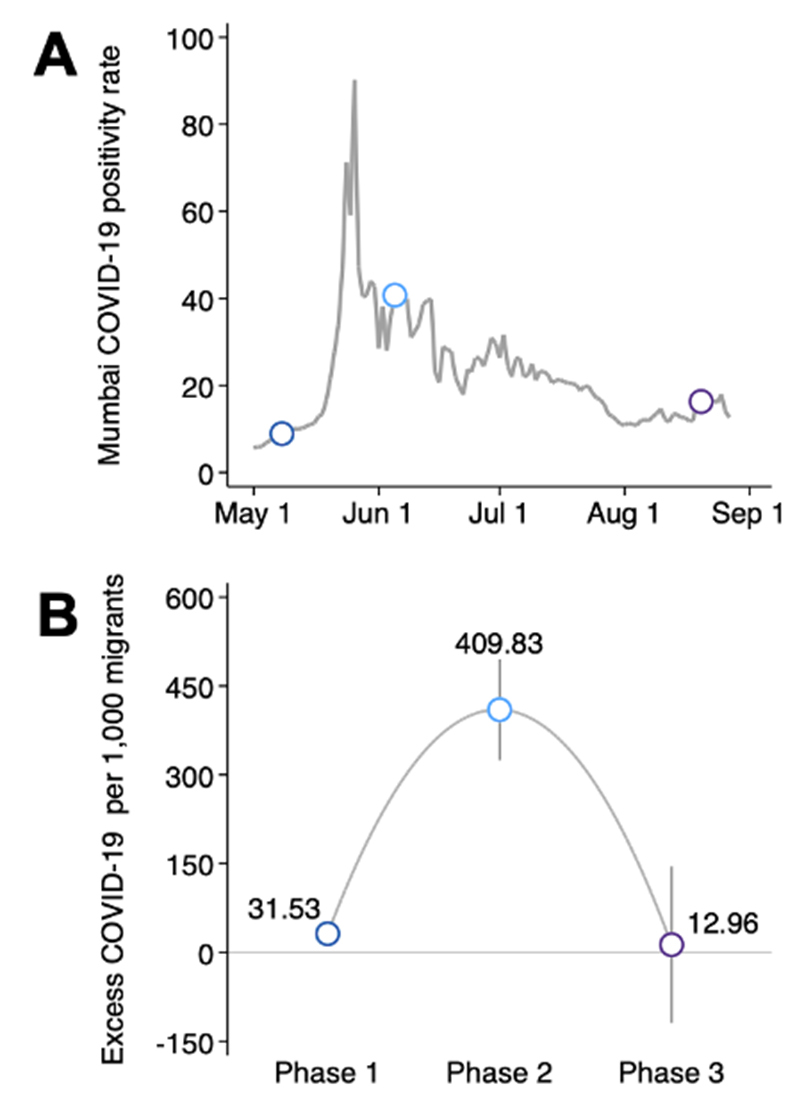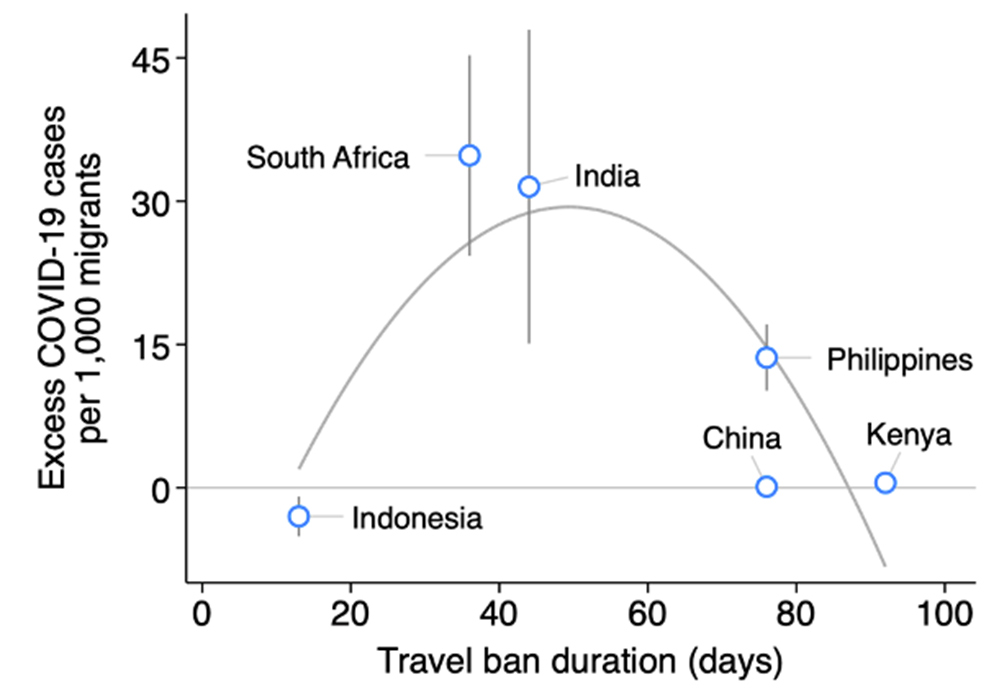At the outset of the Covid-19 pandemic, the developing world took many of the same policy steps as developed nations to contain the spread, including lockdowns. This article uses evidence from India to show that domestic travel bans may actually have increased Covid-19 cases in developing countries with large urban-rural migrant populations. While travel bans are in place, spread is temporarily stopped, but when travel is finally permitted, migrants return home possibly carrying many more infections than if they had been allowed to leave early.
A version of this article was first published on VoxEU on 27 June 2021.
Across the developed world, the policy debate around the Covid-19 pandemic has shifted away from crisis management towards an assessment of damage, how to spur economic recovery, and even the origins of the Virus. With large proportions of their populations at least partially vaccinated – 52% in the US, 61% in the UK, and 48% in Germany, as of 11 June 2021 (Mathieu et al. 2021) – the pandemic seems to be receding.
A very different reality confronts developing countries. A brutal second wave of the pandemic in India took more than 200,000 lives according to the government’s official estimates, and unofficial estimates which adjust for undercounting (The Economist, 2021) project that over one million people have died. The worst is not likely to be over yet, as vaccination rates in the developing world remain extremely low. By 11 June, only 25% of Brazil, 15% of India, and 1% of Nigeria had received at least one dose (Mathieu et al. 2021). We have already begun to see third pandemic surges. In Tunisia, for instance, the ongoing third wave has already taken roughly 3,000 lives (Dong et al. 2020) in a population of just 11.8 million.
At the outset of the pandemic, the developing world took many of the same policy steps as developed nations, with leaders across the globe receiving similar advice from epidemiologists. Lockdowns were a very popular policy approach, implemented across the world. Developed countries such as the US, Germany, Australia, and Singapore imposed stay-home orders and limits on social gatherings, and developing countries including China, Indonesia, the Philippines, South Africa, and Kenya implemented internal travel bans varying from a few weeks to several months (Hale et al. 2021).
These measures have had a considerable impact on the global economy. According to a recent IMF (International Monetary Fund) report (Barrett et al. 2021), world output is expected to be roughly 3% lower in 2024 than anticipated pre-pandemic, with less-developed countries expected to suffer the most. In India, where the government implemented one of the most stringent lockdowns, the combined economic consequences of the pandemic and policy responses to it have been devastating even with an incomplete accounting. The Indian economy shrank by an astonishing 23.9% in the first quarter of 2020. Over the year, the country entered a technical recession, with the government reporting a 7.7% contraction in GDP (gross domestic product). Across the developing world, the pandemic has had severe economic consequences. Over 200 million people are expected to be pushed back into poverty, with 95 million joining the ranks of the extreme poor, and over 255 million jobs lost in developing countries.
Though the scale of the economic consequences of lockdowns may have exceeded even the gloomiest expectations, they were not undertaken lightly. Policymakers around the world have been forced to weigh the costs of shuttering the economy against the toll of Covid-19 infections. Lockdown decisions in the face of the first and second waves of the pandemic were based on standard models of disease spread calibrated largely to developed countries (Ferguson et al. 2020, Flaxman et al. 2020, Greenstone and Nigam 2020, Hsiang et al. 2020). Many of the early empirical evaluations of these lockdowns, too, drew upon data from developed countries, but were then used to support similar policies in the developing world, with arguably far too little attention paid to questions of external validity (Li et al. 2020).
Several economists warned policymakers that developing countries, with their vastly more vulnerable populations, practically non-existent healthcare systems, and large informal sectors, would not only find it difficult to implement several of the WHO’s (World Health Organization) recommended non-pharmaceutical interventions but would face far higher costs than richer parts of the world (Barnett-Howell and Mobarak 2020, Brown et al. 2020, Loayza 2020). Nevertheless, lockdowns were imposed around the world.
Given the potentially large economic consequences of these lockdowns, have they at least reduced Covid-19 cases? There are reasons to believe they might – at the very least – have been less effective than desired, particularly in poor countries. Research shows that inequities in wealth, even within rich countries, translate into significant differences in the effectiveness and implementation of social distancing (Bonaccorsi et al. 2020, Weill et al. 2020, Wright et al. 2020).
In recent research, we show that domestic travel bans may have increased Covid-19 cases in India and around the developing world (Burlig et al. 2021)1. The potential for domestic mobility restrictions to backfire and produce lose-lose outcomes in developing countries may appear counterintuitive but is in fact driven by a simple theoretical mechanism. Developing countries, unlike their wealthier counterparts, are home to large numbers of domestic migrants2. In countries like India, these workers form a highly vulnerable section of society. They work in the informal sector (Dhingra 2020), earning low wages in cash. They are largely undocumented and therefore invisible to social safety nets, with limited engagement with the banking sector. They are quickly affected by economic shocks. Under lockdowns, this population grew financially desperate, trapped in cities that were pandemic hotspots and far from their families in their home villages (Abi-Habib and Yasir 2020).
Models of social distancing frequently treat travel restrictions as eliminating trips. For a population of this type, however, they merely delay the timing of travel. While migrants are detained inside a city where infections are growing rapidly, Covid-19 cases will quickly spread within this population. While a travel ban is in place, the spread of the disease in migrants’ rural home districts is indeed temporarily stopped. However, when travel is finally permitted – as is inevitable in most democracies – migrants will still go home. When they do so, they may carry many more infections than if they had been allowed to leave early. The apparent reduction in the spread of disease whilst the ban was in force may be replaced by a far more intense surge in community spread in rural areas once it is released. The net result can be more Covid-19 cases and large economic and social costs.
This is precisely what we document in India. We use a simple SEIR (Susceptible-Exposed-Infectious-Removed) model calibrated to disease parameters that reasonably describe the first wave in India to show that once travel is modelled as necessary, the moderately lengthy travel restrictions imposed by India are indeed predicted to raise total cases (see Figure 1). This theoretical mechanism also appears to be reflected in empirical data and estimates from a ‘natural experiment’ in Mumbai, India’s financial capital and first Covid-19 hotspot, and subject to several restrictions on long-distance travel.
Figure 1. Predicted infections following travel ban releases

Notes: (i) This figure plots SEIR model simulations of cumulative excess rural sink infections per 1,000 migrants (vertical axis) following the release of travel bans of varying durations (horizontal axis). (ii) We compare excess rural sink cases to a counterfactual in which migrants leave the source immediately. (iii) Vertical grey lines mark hypothetical short, long, and intermediate bans; blue markers indicate excess cases caused by bans of these lengths. (iv) Brackets compare intermediate and long bans with a short ban.
Mumbai saw the imposition of bans by both the national and state government. The first set of restrictions were imposed on 25 March 2020, preventing travel between districts and across state boundaries. These restrictions were lifted for people leaving Mumbai on 8 May 2020 (Phase 1), when a set of special trains began running to take inter-state migrant workers home (Mehta 2020). For migrants seeking to return to other parts of Maharashtra – incidentally, also the third most populous country subdivision in the world – travel remained banned. These restrictions were lifted for some districts on 5 June 2020 (Phase 2) and for others on 20 August 2020 (Phase 3). In short, we observe a single source of infections, but multiple travel bans affecting different parts of India for different periods of time. We combine this policy variation with detailed data on daily cases and deaths in India, as well as information on the share of migrants estimated to come to Mumbai from other districts across India.
Our findings are striking (see Figure 2). For all three ban durations, the number of estimated excess Covid-19 cases in travel destinations hovers around zero until each ban is released. This is consistent with our hypothesis that active travel bans temporarily halt disease transmission. But after the bans were relaxed, we find that cases per migrant rose significantly in Phase 1 districts (about 6 weeks), even more sharply in Phase 2 districts (about 10 weeks), and very little in areas subjected to the longest restrictions (about 20 weeks). We use event-study methods to ensure these changes can be attributed to the timed return of migrants and not natural increases in cases across the country.
Figure 2. Results from the Mumbai natural experiment

Notes: (i) Panel A shows the Mumbai’s Covid-19 case positivity rate ‘time series’ (moving average of prior seven days). (ii) Dots mark the Phase 1 (dark blue), Phase 2 (light blue), and Phase 3 (purple) release dates. (iii) Panel B shows regression estimates of excess Covid-19 cases per 1,000 Mumbai migrants in Phase 1, Phase 2, and Phase 3 districts 30 days after travel ban releases. (ii) A confidence interval is a way of expressing uncertainty about estimated effects. A 90% confidence interval, means that if you were to repeat the experiment over and over with new samples, 90% of the time the calculated confidence interval would contain the true effect. 90% confidence intervals are shown in grey vertical bars.
This outcome may not be restricted to India. We find suggestive evidence of this phenomenon by combining epidemiological data and information on travel bans and migrant populations from five other developing countries: China, Indonesia, the Philippines, South Africa, and Kenya. Like India, these countries have large urban-rural migrant populations and imposed domestic travel bans at the start of the pandemic. Together with India, they make up roughly 40% of the world’s population. Each country imposed domestic travel restrictions of varying durations at varying times. We find that rural cases rose when bans were ended, but less (more) so in cases where restrictions were lifted when per-capita cases in source hotspots were low (high) (see Figure 3).
Figure 3. Cross-country comparisons

Notes: (i) The figure shows excess Covid-19 cases per 1,000 hotspot migrants 30 days after each country's travel ban release. (ii) 90% confidence intervals are shown in grey vertical bars. (iii) ‘Parabolic curve’ is an unweighted quadratic function fit to the estimate for each country.
What can we take away from these findings? First, they highlight the importance of taking local economic and social conditions into account in epidemiological models. Models built for the developed world may not work to model the developing world, and vice versa. Second, the mechanism we describe shows why evaluating the impact of travel restrictions before they are lifted can be highly misleading. Research which draws conclusions about the effectiveness of bans shortly after they are imposed, or immediately after they are lifted, risks capturing only the benefits of these bans and failing to measure the costs – even ignoring the economic consequences of lockdowns. Third, the high costs of lockdowns simply cannot be separated from their effectiveness. When a policy causes significant economic harm, the ability of a democratic government to keep it in place for a long time is also likely to be limited, in turn reducing the effectiveness of the policy.
Overall, the evidence suggests that lockdowns in the developing world both impose severe economic consequences to vulnerable populations, and, if not left in place for a long time, have the potential to increase, rather than reduce, disease incidence. We therefore suggest that policymakers exercise caution when imposing domestic travel restrictions in countries with large domestic migrant populations.
I4I is now on Telegram. Please click here (@Ideas4India) to subscribe to our channel for quick updates on our content
Notes:
- We collect Covid-19 epidemiological data from a variety of national data sources collated by open-source organisations; information on travel ban dates for different countries was collected from news reports, government orders, and official press releases; migration data come from national government statistical agencies’ censuses, enumerated in 2011; and population data are obtained from the 2011 Census of India.
- A United Nations report that examines data from 70 countries and more than 70% of the global population finds that more than 763 million people were living within their home country but outside their region of birth in 2005 (United Nations Population Division, 2013).
Further Reading
- Barnett-Howell, Z and AM Mobarak (2020), ‘The Benefits and Costs of Social Distancing in Rich and Poor Countries’, arXiv preprint.
- Barrett, P, S Das, G Magistretti, E Pugacheva and P Wingender (2021), ‘After-Effects of the COVID-19 Pandemic: Prospects for Medium-Term Economic Damage’, IMF Working Paper No. 2021/203.
- Bonaccorsi, Giovanni et al. (2020), “Economic and Social Consequences of Human Mobility Restrictions Under COVID-19”, Proceedings of the National Academy of Sciences, 117(27): 15530-15535.
- Brown, C, M Ravallion and D van de Walle (2020), ‘The World’s Poor Cannot Protect Themselves Well from the Novel Coronavirus’, VoxEU, 27 June.
- Burlig, FA Sudarshan and G Schlauch (2021), ‘The Impact of Domestic Travel Bans on COVID-19 is Nonlinear in Their Duration’, NBER Working Paper No. 28699.
- Dhingra, S (2020), ‘Protecting Informal Workers in Urban India: The Need for a Universal Job Guarantee’, VoxEU, 2 May.
- Dong, Endheng, Hongru Du and Lauren Gardner (2020), “An Interactive Web-Based Dashboard to Track COVID-19 in Real Time”, The Lancet Infectious Diseases 20(5): 533-534.
- Ferguson, N et al. (2020), ‘Report 9: Impact of Non-Pharmaceutical Interventions (Npis) To Reduce Covid19 Mortality and Healthcare Demand’, Imperial College London Report.
- Flaxman, Seth et al. (2020), “Estimating the Effects of Non-Pharmaceutical Interventions on COVID-19 in Europe”, Nature, 584(7820): 257-261.
- Greenstone, M and V Nigam (2020), ‘Does Social Distancing Matter?’, Becker Friedman Institute for Economics Working Paper 2020-26.
- Hale, Thomas et al. (2021), “A Global Panel Database of Pandemic Policies (Oxford COVID-19 Government Response Tracker)”, Nature Human Behaviour, 5(4): 529-538.
- Hsiang, Solomon et al. (2020), “The Effect of Large-Scale Anti-Contagion Policies on the COVID-19 Pandemic”, Nature, 584(7820): 262–267.
- Li, Ruiyun, Sen Pei, Bin Chen, Yimeng Song, Tao Zhang, Wan Yang and Jeffrey Shaman (2020), “Substantial Undocumented Infection Facilitates the Rapid Dissemination of Novel Coronavirus (SARS-CoV-2)”, Science, 368(6490): 489-493.
- Loayza, NV (2020), ‘Costs and Trade-offs in the Fight Against the Covid-19 Pandemic: A Developing Country Perspective’, World Bank Research and Policy Brief No. 35.
- Mathieu, Edouard et al. (2021), “A Global Database of COVID-19 Vaccinations”, Nature Human Behaviour, 5: 947-953.
- United Nations Population Division (2013), ‘Cross-National Comparisons of Internal Migration: An Update on Global Patterns and Trends’, Technical Paper No. 2013/1, United Nations.
- Weill, Joakim A, Matthieu Stigler, Olivier Deschenes and Michael R Springborn (2020), “Social Distancing Responses to COVID-19 Emergency Declarations Strongly Differentiated by Income”, Proceedings of the National Academy of Sciences, 117(33): 19658-19660.
- Wright, Austin L, Konstantin Sonin, Jesse Driscoll and Jarnickae Wilson (2020), “Poverty and Economic Dislocation Reduce Compliance With COVID-19 Shelter-in-Place Protocols”, Journal of Economic Behavior & Organization, 180: 544–554.




 01 October, 2021
01 October, 2021 






Comments will be held for moderation. Your contact information will not be made public.